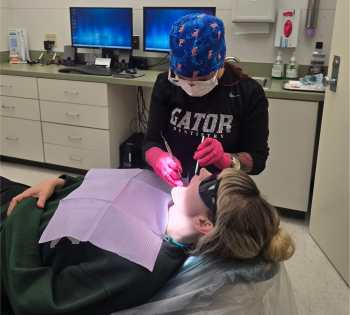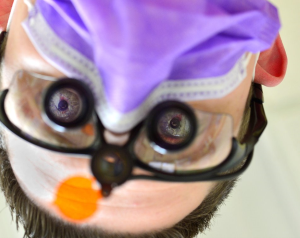Enter your email to receive the CareQuest newsletter:
May 20, 2025
Early in her career as a dental assistant, Mary Lynne Davis, CRDH, had the privilege of working with a dentist who was deeply committed to creating a comfortable, caring experience for every patient. His passion left a lasting impression on her, shaping the way she approached patient care throughout her career as an assistant, a hygienist, a mentor, and now a research coordinator.

“I believe that by prioritizing positive dental experiences, especially from a young age, we can shift the culture of dentistry from reactive treatment to proactive prevention,” Davis says. “This not only leads to better oral health outcomes for patients of all ages but also has the potential to create generational change in how families view and engage with dental care.”
Davis and her colleague Daniel McNeil, PhD, presented about their unique approach and program — Dental-Child Interaction Training (DCIT) — at last month’s National Oral Health Conference in Orlando. DCIT, Davis shared, equips providers with effective behavioral strategies to improve child cooperation and reduce anxiety.
“Since many children are anxious and fearful about getting dental care, or just uncertain about what is going to happen, a very high level of interpersonal skill is required of providers to help kids feel comfortable,” Davis adds.

Below, Davis shares more about the program, opportunities for training, and the team’s ongoing work to make oral health more accessible for some of the youngest patients.
Can you share a bit more about the DCIT program?
Since most children are seen by general dentists and dental hygienists, it’s essential that they have the skills to work positively and effectively with kids. Initially, a research study funded by the National Institute of Dental and Craniofacial Research (NIDCR) helped determine what skills were being used in general dental practice to work with children. Those findings illuminated specific skills that most providers could enhance to make dental appointments a comfortable experience for kids.

during a dental appointment, an image Davis
and colleagues shared during the NOHC
presentation.
After that initial study, the NIDCR funded a seven-year project to confirm the effectiveness of DCIT for dentists, dental hygienists, dental therapists, dental assistants, and anyone interacting with children in the dental setting. Together with partners from the University of North Carolina Chapel Hill, the University of Arkansas, West Virginia University, and a team of colleagues at the University of Florida (UF) College of Dentistry, the effectiveness of this continuing education (CE) training will be tested over the next few years in full-day workshops for dental providers.
Did the UF College of Dentistry develop the program?
Dr. Dan McNeil and Dr. Cheryl McNeil — both clinical psychologists — pioneered DCIT, and are the principal investigators for the DCIT grants. They joined the UF faculty from West Virginia University three years ago, bringing DCIT with them. Their intent is to offer the DCIT skills training to dental providers across several states, where it is being tested, and ultimately, to offer the training nationally and internationally.
How is DCIT different from other techniques?
Grounded in clinical child and behavioral psychology, DCIT focuses on teaching evidence-based interactional skills to dental providers working with children ages 2–10. Adapting core principles from Parent-Child Interaction Therapy (PCIT) to the dental setting, DCIT equips providers with effective behavioral strategies to improve child cooperation and reduce anxiety. Just as PCIT emphasizes the importance of parent-child interactions, DCIT focuses on positive communication, guided participation, and reinforcement to build trust and foster a more comfortable dental experience.
Can you briefly explain the PRIDE skills that are part of DCIT?
Sure, the PRIDE skills are just that: Praise, Reflect, Imitate, Describe, Enjoy/Enthusiasm. They are key components of DCIT, designed to modify how dental providers interact with young patients. These strategies help improve communication and cooperation during dental visits.
- Praises (both labeled and unlabeled) are used to reinforce appropriate behavior.
- Reflections involve repeating or rephrasing the child’s language to acknowledge their communication.
- Imitation encourages the provider to mirror the child’s actions, fostering connection.
- Describe involves verbally sharing what the provider observes the child doing or saying.
- Enjoy/Enthusiasm incorporates humor and excitement to make the visit more positive and engaging.
Can you give some examples of teaching points from DCIT? What should providers say or avoid saying?
DCIT employs positive communication tools to foster cooperation during child interactions. These tools include:
- Labeled praises, such as “Thank you for keeping your mouth open.”
- Direct commands, like “Please open your mouth.”
- Imitation, with statements like “You are opening your mouth like a lion.”
In addition, DCIT emphasizes language to avoid, referred to as “The Avoid Skills.” These include frequent questions that don’t allow the child time to respond, rapid-fire commands that don’t provide the child with a chance to comply, and negative language such as “no,” “don’t,” “stop,” “quit,” and “not.”
Why is an immersive one-day session the preferred delivery method?
DCIT workshops are eight-hour CE sessions that are immersive, experiential, and immediately applicable. Led by a team of experts in behavioral psychology and clinical dental care, these workshops combine didactic learning with hands-on role-play to bridge the gap between theory and practice.
Traditional dental education (i.e., dental school, hygiene programs, or assistant training) offers limited exposure to managing children in the operatory. While countless articles outline pediatric behavior guidance techniques, the DCIT approach takes these methods off the page and into real-world, interactive training.
Through in-the-moment (“in vivo”) coaching, engaging role-play scenarios, and practical strategies for navigating challenging behavior, DCIT equips providers with the confidence and skills to create a supportive, child-friendly environment. The result, we believe, is improved cooperation, more positive dental visits, and stronger foundations for lifelong oral health.
What can a reader do if they want to learn more about the training?
Readers can contact me via email or phone — MDavis@dental.ufl.edu, (352) 222-7034 — and I would be happy to discuss the training workshops and answer any other questions.